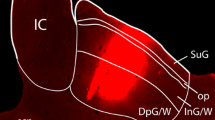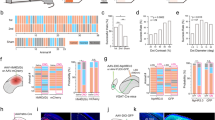Summary
Mongolian gerbils received either lesions of the superior colliculus, small lesions of the uncrossed efferents of the superior colliculus, knifecuts of the dorsal tegmental decussation, or sham operations. The animals were subsequently tested for avoidance of overhead visual threat, orientation and locomotion toward small targets, and negotiation of a large barrier in order to reach a small target. Animals with collicular lesions showed no responses to overhead threat and had severe deficits in orienting to small targets. Animals with lesions of the uncrossed tectal efferents showed diminished responses to overhead threat but had no deficits in orienting to targets. Animals with lesions of the dorsal tegmental decussation showed only slight reductions in responses to overhead threats but clear impairments in the orientation tasks. The impairments in orientation, however, were less severe than those seen in collicular animals. Animals in all groups were able to negotiate barriers efficiently. These results suggest that separate output pathways of the superior colliculus mediate different types of visuomotor behaviours. The results further suggest that visual orientation to small targets does not depend completely on output through the predorsal bundle, but must also involve other collicular outputs.
Similar content being viewed by others
References
Blanchard DC, Williams G, Lee EMC, Blanchard RJ (1981) Taming of wild Rattus norvegicus by lesions of the mesencephalic gray. Physiol Psychol 9: 157–163
Casagrande JA, Harting JK, Hall WC, Diamond IT, Martin G (1972) Superior colliculus of the tree shrew: a structural and functional subdivision into superficial and deep layers. Science 177: 144–147
Chambers JW (1983) A simpler retractable wire knife. Brain Res Bull 10: 865–869
Clark MM, Galef BB (1979) A sensitive period for the maintenance of emotionality in Mongolian gerbils. J Comp Physiol Psychol 93: 200–210
Collett TS (1982) Do toads plan routes? A study of detour behaviour of Bufo viridis. J Comp Physiol 146: 261–271
Dean P, Redgrave P (1984) Superior colliculus and visual neglect in rat and hamster. III. Functional implications. Brain Res Rev 8: 155–163
Ellard CG, Goodale MA (1986) The role of the predorsal bundle in head and body movements elicited by 8 electrical stimulation of the superior colliculus in the Mongolian gerbil. Exp Brain Res 64: 421–433
Fentress JC (1968) Interrupted ongoing behaviour in two species of vole (Microtus agresstis and Cethrionomys britannicus). I. Response as a function of preceding activity and the context of an apparently “irrelevant” motor pattern. Anim Behav 16: 135–153
Goodale MA (1983) Vision as a sensorimotor system. In: Robinson TE (ed) Behavioral approaches to brain research. Oxford New York, pp 41–61
Goodale MA (1983b) Neural mechanisms of visual orientation in rodents: targets versus places. In: Hein A, Jeannerod M (eds) Spatially oriented behavior. Springer, erlin Heidelberg New York, pp 35–62
Goodale MA (in press) Modularity in visuomotor control: from input to output. In: Pylyshyn Z (ed) Computational approaches to human vision: an indisciplinary perspective. Ablex NJ
Goodale MA, Milner AD (1982) Fractionating orienting behaviour in rodents. In: Ingle DJ, Goodale MA, Mansfield R (eds) The analysis of visual behavior. MIT Press, Cambridge Mass, pp 267–299
Goodale MA, Murison RCC (1975) The effects of lesions of the superior colliculus on locomotor orientation and the orienting reflex in the rat. Brain Res 88: 243–255
Goodale MA, Foreman NP, Milner AD (1978) Visual orientation in the rat: a dissociation of deficits following cortical and collicular lesions. Exp Brain Res 31: 445–457
Hikosaka O, Wurtz RH (1983) Visual and oculomotor functions of monkey substantia nigra pars reticulata. III. Memory-contingent visual and saccade responses. J Neurophysiol 49: 1268–1284
Huerta M, Harting J (1982) Tectal control of spinal cord activity: neuroanatomical demonstration of pathways connecting the superior colliculus with the cervical spinal cord grey. In: Kuypers HGJM, Martin GF (eds) Descending pathways to the spinal cord. Elsevier, Amsterdam, pp 293–328
Huerta M, Harting J (1984) The mammalian superior colliculus: studies of its morphology and connections. In: Vanegas H (ed) Comparative neurology of the optic tectum. Plenum Press, New York, pp 687–773
Ingle DJ (1970) Visuomotor functions of the frog optic tectum. Brain Behav Evol 3: 57–71
Ingle DJ (1973) Evolutionary perspectives on the function of the optic tectum. Brain Behav Evol 6: 211–237
Ingle DJ (1980) Some effects of pretectum lesions on the frog's detection of stationary objects. Behav Brain Res 1: 139–163
Ingle DJ (1982) Organization of visuomotor behaviors in vertebrates. In: Ingle D, Goodale MA, Mansfield R (eds) The analysis of visual behavior. MIT Press, Cambridge Mass, pp 67–109
Ingle DJ (1983) Brain mechanisms of visual localization by frogs and toads. In: Ewert J-P, Capranica RR, Ingle DJ (eds) Advances in vertebrate neuroethology. Plenum Press, New York, pp 177–226
Ingle DJ, Shook BL (1985) Action-oriented approaches to visuospatial brain functions. In: Ingle DJ, Jeannerod M, Lee DN (eds) Brain mechanisms and spatial vision. Nijhoff, Boston Mass, pp 229–258
Ingle DJ, Cheal M, Dizio P (1979) Cine analysis of visual orientation and pursuit by the Mongolian gerbil. J Comp Physiol Psychol 93: 919–928
Jones RB, Mills AD (1983) Estimation of fear in two lines of the domestic chick. Behav Proc 8: 243–253
Kilpatrick IC, Collingbridge GL, Starr IC (1982) Evidence for the participation of nigrotectal gamma-aminobutyrate containing neurones in striatal and nigral-derived circling in the rat. Neuroscience 7: 207–222
May PJ, Hall WC (1984) Relationships between the nigrotectal pathway and the cells of origin of the predorsal bundle. J Comp Neurol 226: 357–376
Merker B (1980) The sentinel hypothesis: a role for the mammalian superior colliculus. Unpublished doctoral dissertation. Massachussets Institute of Technology
Milner AD, Lines CR (1983) Stimulus sampling and the use of distal visual cues in rats with lesions of the superior colliculus. Behav Brain Res 8: 387–401
Mlinar EJ, Goodale MA (1984) Cortical and tectal control of visual orientation in the gerbil: evidence for parallel channels. Exp Brain Res 55: 33–48
Paxinos G, Watson C (1982) The rat brain in stereotaxic coordinates. Academic Press, New York
Pope SG, Dean P (1979) Hyperactivity, aphagia and motor disturbance following lesions of the superior colliculus and underlying tegmentum in rats. Behav Neurol Biol 27: 433–453
Sahibzada N, Dean P, Redgrave P (1986) Movements resembling orientation or avoidance elicited by electrical stimulation of the superior colliculus in rats. J Neurosci 6: 723–733
Thiessen D, Yahr P (1977) The gerbil behavioral investigations. Texas University Press, Austin TX
Wurtz RH, Goldberg ME (1972) Activity of superior colliculus in behaving monkey. IV. Effects of lesions on eye movements. J Neurophysiol 35: 587–596
Author information
Authors and Affiliations
Rights and permissions
About this article
Cite this article
Ellard, C.G., Goodale, M.A. A functional analysis of the collicular output pathways: a dissociation of deficits following lesions of the dorsal tegmental decussation and the ipsilateral collicular efferent bundle in the Mongolian gerbil. Exp Brain Res 71, 307–319 (1988). https://doi.org/10.1007/BF00247491
Received:
Accepted:
Issue Date:
DOI: https://doi.org/10.1007/BF00247491




